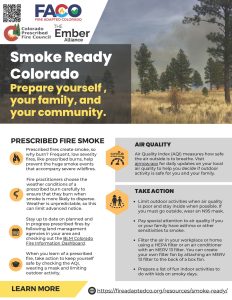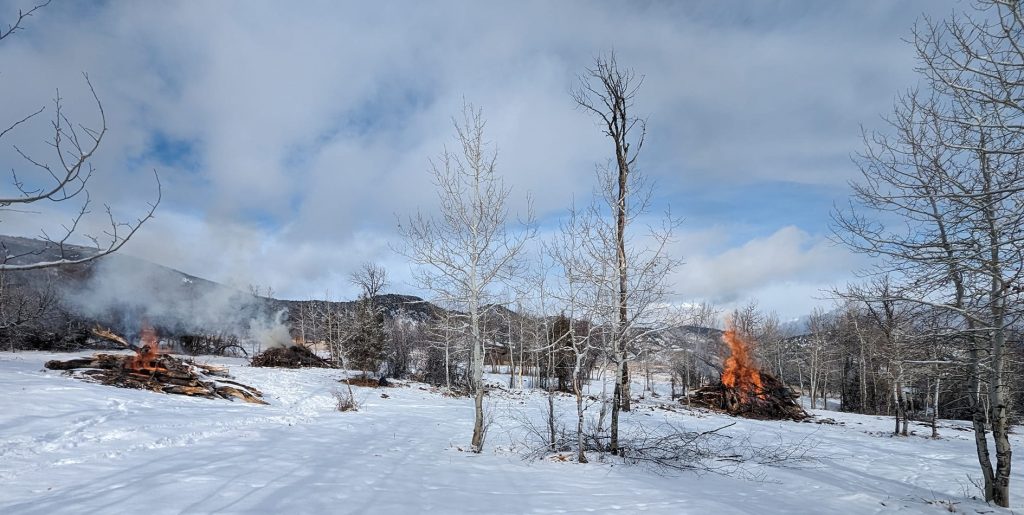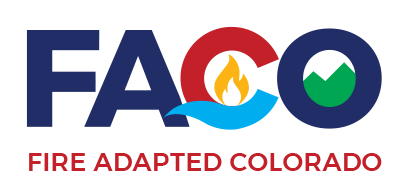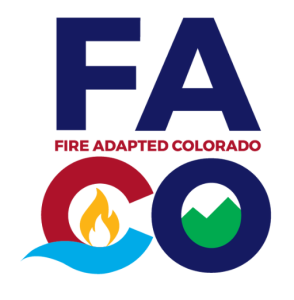Clearing the Air: Smoke Ready Colorado
With an emphasis on prescribed fire, The Ember Alliance, Fire Adapted Colorado, and the Colorado Prescribed Fire Council, with funding support from the US DOI Bureau of Land Management, have just published a web-based resource for a Smoke Ready Colorado.
The web-based campaign provides resources to protect yourself when there is smoke in the air, prescribed fire and wildfire resource links and examines the importance of restoring our relationship with fire.
Located on the FACO Resources web page, the Smoke Ready campaign digests particulate matter (PM) basics, especially the microscopic kind (PM2.5) found in wildfire and prescribed fire smoke, that can irritate the lungs and adversely affect respiratory and cardiovascular health.
The primarily public-facing campaign also addresses smoke exposure and health risks, resources for tracking smoke, and a brief discussion of the benefits and need for prescribed and managed fire. The interactive page provides trusted resources from sources, including the EPA, CDPHE, IWFAQRP, and AirNow.gov, including resources for monitoring air quality and smoke and tools to prepare and protect indoor air quality before a wildfire.
Network participants and other professionals can also reference the resources, including a smoke-ready toolkit with links to trusted sources for up-to-date information about mitigating health risks and preparing for smoke before wildfires occur. In addition to sharing important information about the health impacts of smoke, low-cost solutions to protect communities from smoke are provided, including guidance like creating clean rooms within your home, learning how to make low-cost air filters, and how to monitor air quality and fire activity impacting your community. For a deeper dive, see the FACO December 23′ Newsletter resources section for additional resources not included in the Smoke Ready section of the FACO website.

Smoke Ready Colorado flyer
‘The concept of a “smoke-ready community” is still relatively new. The U.S. Forest Service (USFS) started using the term in 2016 and has since partnered with the U.S. Environmental Protection Agency (EPA) to help communities prepare for the impacts of smoke during worsening fire seasons.
The Interagency Wildland Fire Air Quality Response Program (IWFAQRP) – a group within the USFS – defines smoke readiness as when “communities and individuals have the knowledge and ability to stay reasonably safe and healthy during smoke episodes.” While the definition is straightforward, implementation in smoke-impacted communities is complex—especially as the number of communities impacted by wildfire smoke grows with each season.’
– Aspen Global Change Institute | Savannah M. D’Evelyn, University of Washington | Smoke-ready communities: Learning to live with wildfire smoke
‘Prescribed fires and managed wildland fires result in significantly less severe smoke emissions than unplanned, high-severity wildfires, and “is critical to dramatically increase both the frequency and scope of beneficial fire to mitigate wildfire impacts to both landscapes and communities.”

Frost Creek pile burn operations Dec 1, 2023 | Eagle Valley Wildland
In addition to this wildfire mitigation function, the landscape-scale use of beneficial fire is necessary for improving ecosystem structure and functions, remediating the effects of decades of fire exclusion, restoring watersheds, and respecting Tribal sovereignty. The deficit of naturally ignited and human-managed fire has already brought deep and long-lasting negative consequences, and the cost of continued inaction – of failing to return fire to the landscape – is high.’
– ON FIRE: The Report of the Wildland Fire Mitigation and Management Commission September 2023

